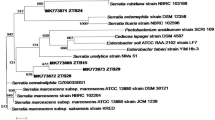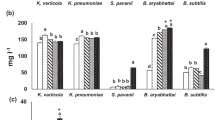Abstract
Zinc is a crucial micronutrient required for healthy plant growth, and a substantial amount of applied zinc in the soil has get fixed into insoluble forms. Zinc-solubilizing bacteria (ZSB) have potential alternates for enhancing the bioavailability of zinc in soil. The field experiment was carried out to evaluate the influence of Pantoea agglomerans strain ZTB17, NCBI accession number: MK773870 with graded levels of zinc fertilizer on maize. Results indicate that the application of 100% ZnSO4 + ZSB showed higher grain, stover and biological yield; however, it did not significantly differ from the treatment of 75% ZnSO4 + ZSB. These results demonstrated a 25% saving of the zinc fertilizer to maize crops owing to the application of the P. agglomerans. The response of P. agglomerans with graded levels of zinc in terms of zinc content and uptake by the plants was significantly higher over the sole utilization of inorganic zinc fertilizer. The maximum zinc concentrations in grain and straw were recorded with 100% ZnSO4 + ZSB treatment; however, it was on par with the rest of the treatments of P. agglomerans with graded levels of inorganic zinc fertilizers. Further, the study on zinc fractions revealed that exchangeable zinc, carbonate bound zinc, organically bound zinc, amorphous bound zinc, and crystalline zinc were raised. The available zinc status in the soil was increased by the application of P. agglomerans with different levels of ZnSO4 over control after the harvest of the crop.
Similar content being viewed by others
References
FAI (2016–2017) Fertiliser Statistics. The Fertiliser Association of India, New Delhi
Jat G, Sharma SK, Meena RH, Jain D, Choudhary R,;, et al (2021) Amelioration of zinc deficiency in blackgram (Vigna mungo L.) through soil applied zinc in Typic Haplustepts soil of Rajasthan. J Environ Biol 42:1554–1559
Cakmak I (2008) Enrichment of cereal grains with zinc: agronomic or genetic biofortification. Plant Soil 302:1–17
Broadley MR, White PJ, Hammond JP, Zelko I, Lux A (2007) Zinc in plants. New Phytol 173:677–702
Andreini C, Bertini I, Rosatn A (2009) Metalloproteomes: a bioformatic approach. Acc Chem Res 42:1471–1479
Alloway BJ (2008) Zinc in Soils and Crop Nutrition, 2nd edn. International Zinc Association and International Fertilizer Industry Association, Brussels
Singh B, Neatesan SKA, Singh BK, Usha K (2005) Improving zinc deficiency of cereals under zinc deficiency. Curr Sci 88:36–44
Zhang X, Jiang B, Ma Y (2017) Aging of zinc added to soils with a wide range of different properties: factors and modelling. Environ Toxicol Chem 36:2925–2933
Rattan RK, Shukla LM (1991) Influence of different zinc carrier on the utilization of micronutrients by rice. J Indian Soc Soil Sci 39:808–810
Hacisalihoglu G (2020) Zinc (Zn): the last nutrient in the alphabet and shedding light on Zn efficiency for the future of crop production under suboptimal Zn. Plants 9:1471. https://doi.org/10.3390/plants9111471
Sukhwal A, Meena R, Jain D, Meena RH, Jat G (2022) Molecular characterization of zinc solubilising bacteria isolated from different rhizospheric soil and assessment of their physiological attributes. Pharma Innovat J 11(3):332–340
Saravanan VS, Kalaiarasan P, Madhaiyan M, Thangaraju M (2007) Solubilization of insoluble zinc compounds by Gluconacetobacter diazotrophicus and the detrimental action of zinc ion (Zn2+) and zinc chelates on root knot nematode Meloidogyne incognita. Lett Appl Microbiol 44:235–241
Kour R, Jain D, Bhojiya AA, Sukhwal A, Sanadhya S, Saheewala H, Jat G, Singh A, Mohanty SR (2019) Zinc biosorption, biochemical and molecular characterization of plant growth-promoting zinc tolerant bacteria. 3Biotech 9:421
Upadhyay SK, Chauhan PK (2022) Optimization of Eco-friendly amendments as sustainable asset for salt-tolerant plant growth-promoting bacteria mediated maize (Zea mays L.) plant growth, Na uptake reduction and saline soil restoration. Environ Res 211:113081. https://doi.org/10.1016/j.envres.2022.113081
Singh JP, Karwasra SPS, Singh M (1988) Distribution and forms of copper, iron, manganese, and zinc in calcareous soils of India. Soil Sci 146:359–366
Panse VG, Sukhatme PV (1989) Statistical Methods for Agricultural Workers. ICAR, New Delhi
Cabot C, Martos S, Llugany M, Gallego B, Tolra R, Poschenrieder (2019) A role for zinc in plant defense against pathogens and herbivores. Front Plant Sci 10:1171
Upadhyay SK, Singh DP (2015) Effect of salt-tolerant plant growth-promoting rhizobacteria on wheat plants and soil health in a saline environment. Plant Biol 17(1):288–293. https://doi.org/10.1111/plb.12173
Paul S, Singh V, Chauhan PK, Srivastava AK, Upadhyay SK (2020) Assessment of carrot growth performance with inoculation of AsT-PGPR under arsenic infested zone. G-J Environ Sci Technol 7(6):78–84
Upadhyay SK, Singh JS, Singh DP (2011) Exopolysaccharide-producing plant growth-promoting rhizobacteria under salinity condition. Pedosphere 2:214–222. https://doi.org/10.1016/S1002-0160(11)60120-3
Upadhyay SK, Singh DP, Saikia R (2009) Genetic diversity of plant growth promoting rhizobacteria isolated from rhizospheric soil of wheat under saline condition. Curr Microbiol 59:489–496. https://doi.org/10.1007/s00284-009-9464-1
Upadhyay SK, Edrisi SA (2021) Developing sustainable measures to restore fly ash contaminated lands: current challenges and future prospects. Land Degrad Dev 32:4817–4831. https://doi.org/10.1002/ldr.4090
Khande R, Sushil KS, Ramesh A, Mahaveer PS (2017) Zinc solubilizing Bacillus strains that modulate growth, yield and zinc biofortification of soybean and wheat. Rhizosphere 4:126–138
Hussain A, Zahir AZ, Ditta A, Tahir MU, Ahmad M, Mumtaz MZ, Hayat K, Hussain S (2019) Production and implication of bio-activated organic fertilizer enriched with zinc-solubilizing bacteria to boost up Maize (Zea mays L.) production and biofortification under two cropping seasons. Agronomy 10:39. https://doi.org/10.3390/agronomy10010039
Dinesh R, Srinivasana V, Hamzaa S, Sarathambala C, Gowdaa SJA, Ganeshamurthy AN, Gupta SB, Aparna Nair V, Subila KP, Lijina A, Divya VC (2018) Isolation and characterization of potential Zn solubilizing bacteria from soil and its effects on soil Zn release rates, soil available Zn and plant Zn content. Geoderma 321:173–186
Bouis HE, Welch RM (2010) Biofortification- a sustainable agricultural strategy for reducing micronutrient malnutrition in the global south. Crop Sci 50:20–32
Ullah MA, Hassan MN, Jamil M, Brader G, Shah MKN, Sessitsch A, Hafeez FY (2015) Plant growth promoting rhizobacteria: An alternate way to improve yield and quality of wheat (Triticum aestivum L.). Int J Agric Biol 17(1):51–60
Mumtaz MZ, Ahmad M, Jamil M, Hussain T (2017) Zinc solubilizing Bacillus spp. potential candidates for biofortification in maize. Microbiol Res 202:51–60
Natasha N, Shahid M, Bibi I, Iqbal J, Khalid S, Murtaza B et al (2022) Zinc in soil-plant-human system: a data-analysis review. Sci Total Environ 808:152024
Priyanka, Sharma SK, Meena RH, Purohit HS (2017) Fractionation and distribution of Zinc under INM system on LTFE’s Maize-wheat cropping system in Typic Heplusteptsoil of Udaipur. Green Farming 8(6):1308–1312
Acknowledgements
The financial assistance from AINP-SBB and RKVY is acknowledged.
Author information
Authors and Affiliations
Corresponding author
Ethics declarations
Conflict of interest
The authors declare that they have no conflict of interest.
Additional information
Publisher's Note
Springer Nature remains neutral with regard to jurisdictional claims in published maps and institutional affiliations.
Significance Statement: India is among the nations with the most zinc-deficient agricultural soils. Hence a field experiment was conducted to evaluate the influence of ZSB and results indicate that the use of ZSB not only showed higher grain, Stover and biological yield but also increased Zn uptake with Zn fortification.
Rights and permissions
Springer Nature or its licensor holds exclusive rights to this article under a publishing agreement with the author(s) or other rightsholder(s); author self-archiving of the accepted manuscript version of this article is solely governed by the terms of such publishing agreement and applicable law.
About this article
Cite this article
Verma, D., Meena, R.H., Sukhwal, A. et al. Effect of ZSB with Graded Levels of Zinc Fertilizer on Yield and Zinc Uptake Under Maize Cultivation. Proc. Natl. Acad. Sci., India, Sect. B Biol. Sci. 93, 379–385 (2023). https://doi.org/10.1007/s40011-022-01433-4
Received:
Revised:
Accepted:
Published:
Issue Date:
DOI: https://doi.org/10.1007/s40011-022-01433-4




